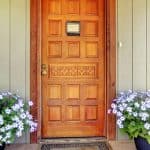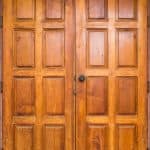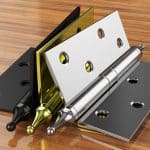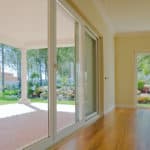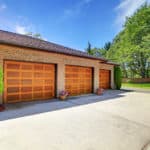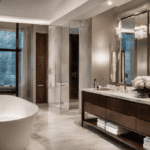
Image that vividly depicts the debate between two and three panel doors
I find myself faced with numerous decisions regarding my home. One debate that has caught my attention is the battle between 2-panel and 3-panel doors. These functional elements serve a purpose and add to a space’s aesthetic appeal.
In this article, we will explore the differences between these doors, discussing their advantages, disadvantages, and factors to consider when choosing the number of panels. Join me as we unravel the door debate and navigate the battle of 2 panels vs. 3 panels.
Key Takeaways
- Panel doors expand and contract based on the number of panels.
- Two-panel doors are popular for their aesthetic appeal and simplicity.
- Three-panel doors are more rigid and durable compared to two-panel doors.
- Panel-look doors lack actual panels and do not provide the expansion and contraction benefits of panel doors.
Benefits of 2-Panel Doors
In my opinion, the benefits of 2-panel doors include their flexible design and suitability for various interior design styles.
Two-panel doors offer several advantages over their counterparts. Firstly, their flexible design allows for expansion and contraction, making them more durable and resistant to warping. This flexibility is especially beneficial in areas with temperature and humidity fluctuations.
Secondly, two-panel doors are known for their aesthetic appeal and simplicity. They’re popular for homeowners looking to achieve a clean and minimalist look.
Additionally, cleaning two-panel doors is relatively easy, making them a practical choice for busy households.
Overall, the advantages of 2-panel doors lie in their adaptable design and ability to seamlessly integrate into different interior design styles, providing both functionality and visual appeal.
Advantages of 3-Panel Doors
The durability and flexibility of three-panel doors make them an excellent choice for exterior doors and areas prone to moisture.
Three-panel doors offer enhanced durability and strength, making them more rigid than two-panel doors. More flex points allow for better expansion and contraction, making them ideal for areas with humidity and temperature changes.
The multiple panels provide more flexibility for installation in different environments, contributing to their overall durability. These doors are suitable for exterior use due to their ability to withstand moisture and harsh weather conditions.
Their durability and flexibility ensure a long-lasting and reliable solution for any space that requires added strength and resistance.
Understanding Panel-Look Vs. True Panel Doors
I prefer the durability and flexibility of true panel doors over panel-look doors for their ability to expand and contract based on their panels. Proper panel doors have actual panels that provide the necessary flexibility to withstand environmental changes. On the other hand, panel-look doors may imitate the appearance of panel doors, but they lack the actual panels and cannot expand and contract. This can be a significant disadvantage, especially in areas with temperature and humidity fluctuations.
To help you understand the differences between panel look and true panel doors, let’s take a look at the pros and cons of panel look doors:
| Pros | Cons |
|---|---|
| Aesthetic appeal | Lack of actual panel functionality |
| Affordable option | Limited durability and flexibility |
| Easy to clean | Not suitable for areas with fluctuations in temperature and humidity |
Key Factors in Choosing the Number of Panels
One of the key factors to consider when choosing the number of panels for a door is the door’s intended installation location and durability.
- More panels contribute to the door’s strength and durability.
- The number of panels affects the door’s flexibility and rigidity.
- The aesthetic features of the door should be secondary to its intended installation location.
When it comes to choosing between two-panel and three-panel doors, understand their differences in terms of strength and durability.
Two-panel doors have a flexible design that allows for expansion and contraction, making them suitable for various interior design styles.
On the other hand, three-panel doors offer enhanced durability and strength, making them ideal for exterior doors and moisture-prone areas.
It’s crucial to evaluate the location and conditions where the door will be installed to ensure it meets the desired level of strength and durability.
Exploring the Debate: 2 Panels Vs. 3 Panels
I’ve been considering whether to go with a two-panel or three-panel door, and I’m curious to hear everyone’s thoughts on the debate.
The benefits of two-panel doors are that they offer a flexible design that allows for expansion and contraction. They’re popular for their aesthetic appeal and simplicity, making them suitable for various interior design styles. Cleaning two-panel doors is relatively easy as well.
On the other hand, three-panel doors have advantages in terms of durability and strength. They’re more rigid and can withstand humidity and temperature changes better than two-panel doors. Three-panel doors are ideal for exterior use and areas prone to moisture. However, one of the disadvantages of three-panel doors is that they’ve more flex points, which can affect their overall durability.
I look forward to hearing your insights on this topic.
Frequently Asked Questions
What Are the Potential Disadvantages of Choosing a Two-Panel Door Over a Three-Panel Door?
When choosing between a two-panel and three-panel door, potential drawbacks include limited expansion and contraction, less durability, and reduced strength. Additionally, aesthetic differences may impact the overall appeal of the door.
Can Panel-Look Doors Be Used for Exterior Doors?
Panel-look doors lack the weather resistance and security features of traditional exterior doors. Consider the potential disadvantages when choosing between panel-look and true panel doors for external use.
Are There Any Specific Maintenance Requirements for Three-Panel Doors?
Maintenance requirements for three-panel doors include regular cleaning and inspection for any signs of damage or wear. Advantages of three-panel doors include enhanced durability and rigidity, while disadvantages may include limited design options and higher cost. Design considerations for two-panel and three-panel doors depend on the door’s location and intended use.
How Do the Costs Compare Between Two-Panel and Three-Panel Doors?
In comparing the cost and long-term durability of two-panel and three-panel doors, consider the specific needs and location of the door. Prices vary based on materials and installation, while durability depends on climate and use.
Are There Any Specific Design Considerations to Keep in Mind When Choosing Between Two-Panel and Three-Panel Doors?
Three-panel doors are more prevalent in modern homes due to their durability and flexibility when considering design trends. The number of panels affects customization options, providing more design possibilities for doors with more panels.
Which Panel Design is More Common in Doors: 2 Panels or 3 Panels?
When it comes to doors, are there more wheels on 2-panel or 3-panel designs? In most cases, 2-panel designs are more common for doors, as they provide a simple and classic look. However, 3-panel designs can also be found in certain architectural styles and offer a more decorative appeal.
Which Panel Configuration is More Secure for Front Doors: 2 Panels or 3 Panels?
When considering the best front door options for security, the panel configuration is an important factor. In general, a 3-panel front door setup offers more security compared to a 2-panel configuration. The extra panel provides added resistance and makes it harder for intruders to force their way in.
2-panel and 3-panel doors is a decision
The battle between 2-panel and 3-panel doors is a decision that shouldn’t be taken lightly. Both options have their advantages, and it ultimately comes down to personal preference and the specific needs of your space.
Whether you choose the sleek simplicity of a 2-panel door or the added elegance of a 3-panel door, the right choice will enhance your home’s functionality and aesthetic appeal.
So, unlock the door of debate and step into a world of possibilities for your space.

Hi, I’m George Anderson, an expert installer with an extensive door installation and maintenance background. I’m passionate about sharing my knowledge on door equipment and accessories through my writing, helping homeowners make informed decisions. My specialty lies in custom door installations, with a commitment to enhancing the aesthetics of every home. Please feel free to reach out anytime for help with door-related questions or needs.


